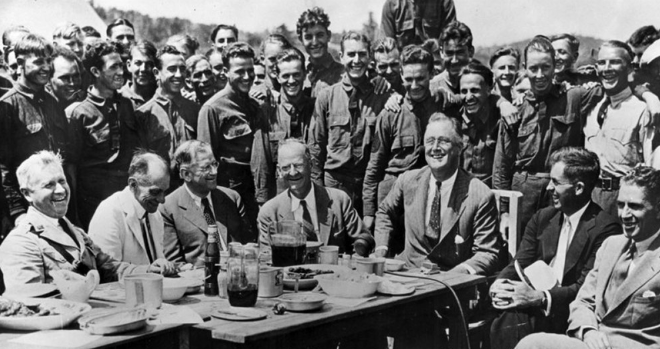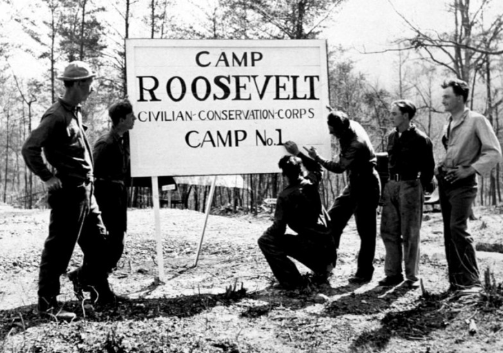
FDR Meets with CCC workers Photo: Harper’s Ferry Center Historical Collection
As we contemplate the sweeping Green New Deal resolution recently introduced, which promises that “public lands, waters, and oceans are protected” and that all Americans have “access to nature,” we should look back at the very green legacy of FDR’s New Deal. As part of historic first 100 days legislation, Roosevelt proposed the Emergency Conservation Work (ECW) Act, more commonly known as the Civilian Conservation Corps (CCC) to put to work unemployed young men in a peacetime “army” and “send them into battle” against destruction and erosion of our country’s natural resources. Within weeks (really 37 days), this idea went from notional to actual — according to the CCC Legacy Project, it “was a miracle of cooperation among all branches and agencies of the federal government. It was a mobilization of men, material and transportation on a scale never before known in time of peace.” Eventually, CCC camps were set up and projects were undertaken in all 48 (at the time) states, Hawaii, Alaska, and various territories.
The National Park Service explains its importance,
- “Franklin Roosevelt’s New Deal programs, combined with his enthusiasm for conservation, laid a firm foundation for protecting the nation’s natural bounty…Soil erosion control, water conservation, the preservation of wildlife, and other environmental protection activities became a part of the everyday life and activities of American citizens…FDR’s programs introduced new concepts on a national level in planning for the responsible use of our natural and historic resources.”
- Also called “Roosevelt’s Tree Army,” according to Smithsonian Magazine, the CCC planted three billion trees in just nine years. “We were building forests,” said Lamonte Dehn, who joined the Corps when he was just 15 years old. Dehn, who planted trees in Minnesota, recalls growing the trees from seedlings.
- The forests planted by the CCC weren’t just for recreation and preservation. They provided conservation benefits and restored areas in order to reduce the terrible erosion and drought that caused and fueled Dust Bowl conditions on the Great Plains.
- The CCC also provided 1,240,000 man-days of emergency work in floods of the Ohio and Mississippi valleys, Vermont and New York, and in response to hurricanes too.
The Smithsonian writes that “the CCC was one of the New Deal’s most productive—and popular—programs. And with good reason: The USDA Forest Service estimates that its members built over a million miles of forest roads and trails, stocked over a billion fish and put in over 6.4 million man-days fighting forest fires. Much of their work was aimed at national parks throughout the country, but the CCC workers contributed to public lands as well.”
The CCC was disbanded at the beginning of World War II, but during its lifetime three million men served. The CCC was originally limited to young, single men but eventually (after a large protest by veterans who encamped in Washington, D.C.) 25,000 unemployed veterans, 80,000 Native Americans, and 25,000 men who were local to the camps were able to join as well. Thanks to a push by First Lady Eleanor Roosevelt, eventually 8500 unemployed women were allowed to join too, living in residential camps (dubbed the “She-She-She” Camps) that forced the upgrading of the standard of living in all the camps.
Why This Matters: To those who are skeptical of the Green New Deal because it is so sweeping and ambitious, we say just look at the scope and accomplishments of the original New Deal. The environment and natural resource challenges we face today are entirely consistent with those tackled by the CCC at the time. And the GND will provide comparable economic and ecological benefits to the original “green” New Deal — now and well into the future. The GND is not unprecedented, at least when it comes to conservation.

Photo: FDR Library
February 18, 2019 » CCC, conservation, Dust Bowl, FDR, floods, GND, Green New Deal, Hurricanes, National Forests, National Parks, soil erosion, the New Deal, trails


